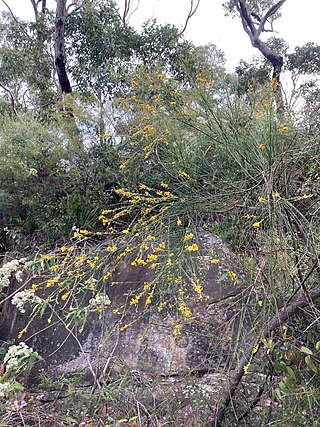
Viminaria juncea is the single species in the genus Viminaria endemic to Australia. The genus is in the pea family Fabaceae. It is colloquially known as native broom after its resemblance to the related European broom plants. The Noongar peoples know the plant as koweda.

Carpobrotus, commonly known as pigface, ice plant, sour fig, Hottentot fig, and clawberry is a genus of ground-creeping plants with succulent leaves and large daisy-like flowers. The name comes from the Ancient Greek karpos "fruit" and brotos "edible", referring to its edible fruits.
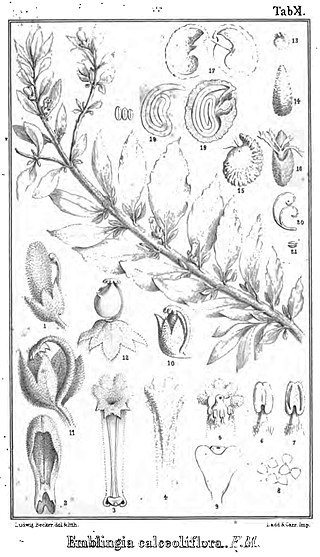
Emblingia is a monospecific plant genus containing the species Emblingia calceoliflora, a herbaceous prostrate subshrub endemic to Western Australia. It has no close relatives, and is now generally placed alone in family Emblingiaceae.

Threlkeldia diffusa, also known as coast bonefruit, is a perennial herb which occurs in coastal areas and saline flats in Australia. It is sometimes prostrate or may grow up to 0.4 metres in height. The green flowers occur between October and November (spring) in its native range.
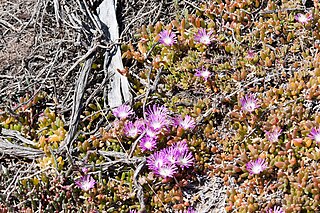
Disphyma crassifolium, commonly known as round-leaved pigface or salty fingers is a species of flowering plant in the family Aizoaceae native to Australia and the Cape Provinces of South Africa. It is a prostrate, succulent annual shrub or short-lived perennial plant with stems up to 2 m long, leaves that are three-sided in cross-section with a rounded lower angle, and purple daisy-like flowers with staminodes up to 30 mm (1.2 in) long.
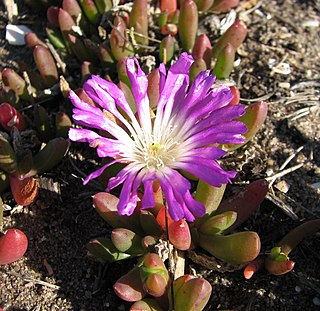
Disphyma crassifolium subsp. clavellatum is the subspecies of Disphyma crassifolium that occurs in Australia and New Zealand. It is sometimes known by the common name rounded noon-flower

Sesuvium portulacastrum is a sprawling perennial herb in the family Aizoaceae that grows in coastal and mangrove areas throughout much of the world. It grows in sandy clay, coastal limestone and sandstone, tidal flats and salt marshes, throughout much of the world. It is native to Africa, Asia, Australia, Hawai`i, North America and South America, and has naturalised in many places where it is not indigenous.
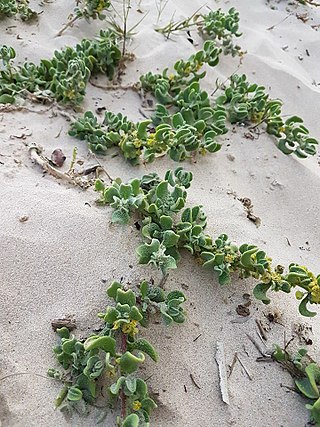
Tetragonia decumbens is a coastal shrub, native to southern Africa.

Carpobrotus glaucescens, commonly known as pigface or iceplant, is a species of flowering plant in the family Aizoaceae and is endemic to eastern Australia. It is a succulent, prostrate plant with stems up to 2 m long, glaucous leaves, daisy-like flowers with 100 to 150 light purple to deep pinkish-purple, petal-like staminodes and red to purple fruit. The fruits ripen mainly in Summer and Autumn. It usually only grows very close to the sea.
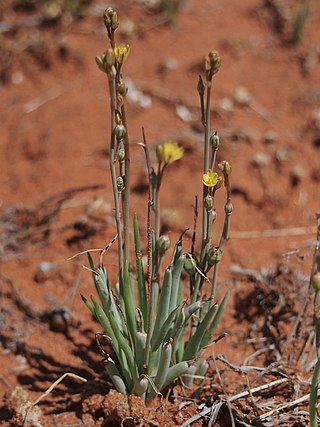
Bulbine semibarbata, commonly known as leek lily, native leek or wild onion, is a species of annual herb native to Australia.
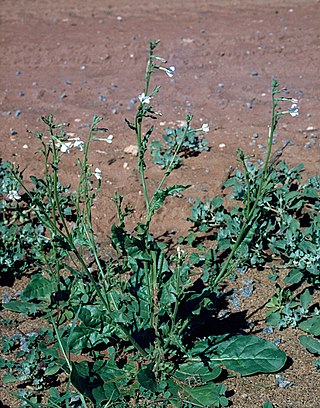
Nicotiana occidentalis, commonly known as native tobacco, is a short-lived herb endemic to Australia.
Plantago debilis is a species of herb native to Australia. Common names include shade plantain and weak plantain.
Aizoon pubescens is a low-growing perennial herb in the family Aizoaceae. It is native to South Africa and naturalised elsewhere.

Adenanthos meisneri, commonly known as prostrate woollybush, is a species of shrub in the family Proteaceae. It is endemic to the south-west of Western Australia.

Adenanthos pungens, the spiky adenanthos, is a species of shrub in the family Proteaceae. It is endemic to the south-west of Western Australia.

Adenanthos × cunninghamii, commonly known as woollybush, Albany woollybush or prostrate woollybush, is a hybrid shrub in the family Proteaceae. It is endemic to the south-west of Western Australia. The Noongar peoples know the plant as boyur.

Xylomelum occidentale, commonly known as the western woody pear, is a tree species in the family Proteaceae. It is endemic to Western Australia.
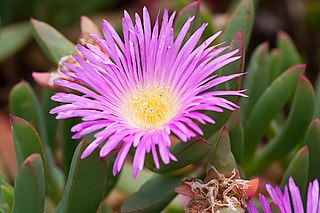
Carpobrotus aequilaterus, common names: angled pigface, Chilean pigface, This species is thought to have originated in southern Africa and a naturalised weed elsewhere. However, according to VicFlora it is native to South Africa, It is also known as the sea fig.
Jacksonia horrida is a species of leguminous plant occurring in Southwest Australia on wetter sandy soil and coastal dune systems. It bears yellow and orange to red flowers and may be prostrate or erect to a height of 2.5 metres. The distribution range extends south of Perth, occurring in higher rainfall coastal regions until reaching the west of the Esperance Plains.
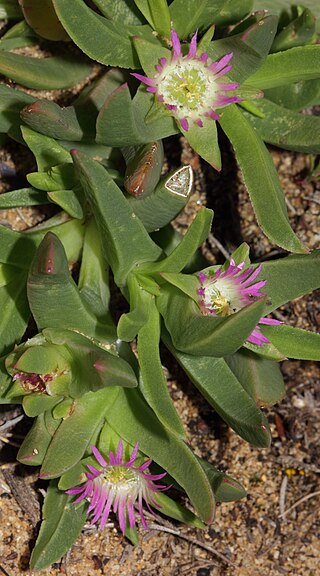
Sarcozona bicarinata, commonly known as ridged noon-flower, is species of flowering plant in the family Aizoaceae and is endemic to Australia. It is a small shrub with leaves that are triangular in cross-section and arranged in opposite pairs, and daisy-like flowers with twenty to fifty-five petal-like staminodes and twenty to fifty stamens.

















